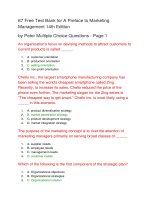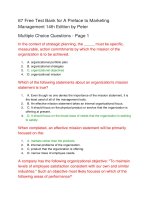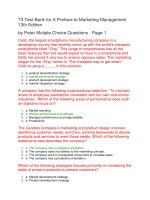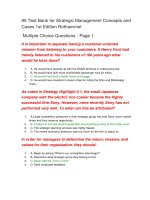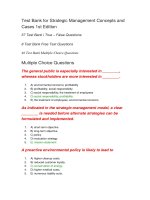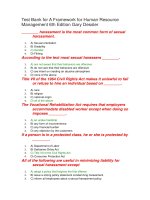Test bank for a framework of international business 1st edition by cavusgil1
Bạn đang xem bản rút gọn của tài liệu. Xem và tải ngay bản đầy đủ của tài liệu tại đây (372.09 KB, 40 trang )
Test Bank for A Framework of International Business 1st
Edition by Cavusgil
Link download full: />Chapter 2 Theories of International Trade and Investment
1) Farm land, diamond mines, and good climate conditions would all be
categorized as comparative advantages for a region.
Answer: TRUE
Diff: 1 Page Ref: 28-29
Skill: Concept
Objective: 2-1
AACSB: Dynamics of the global economy
2) The earliest efforts to explain international business emerged in the early 20th
century.
Answer: FALSE
Diff: 1 Page Ref: 27
Skill: Concept
Objective: 2-1
AACSB: Dynamics of the global economy
3) Modern business executives use the term comparative advantage when referring
to the assets of individual firms.
Answer: FALSE
Diff: 2 Page Ref: 25
Skill: Concept
Objective: 2-1
AACSB: Dynamics of the global economy
4) Specialization prohibits industries and laborers from being productive and
profitable in the arena of international trade.
Answer: FALSE
Diff: 2 Page Ref: 144
Skill: Concept
Objective: 5.1, 5..2, 5.3, 5.4
AACSB: Dynamics of the global economy
5) In Adam Smith's opinion, mercantilism has a positive impact on a nation's
1
Copyright © 2013 Pearson Education, Inc. Publishing as Prentice Hall
wealth because it makes many wealthy people wealthier.
Answer: FALSE
Diff: 1 Page Ref: 26-27
Skill: Concept
Objective: 2-2
AACSB: Dynamics of the global economy
2
Copyright © 2013 Pearson Education, Inc. Publishing as Prentice Hall
6) In theory, nations which adhere to the absolute advantage principle will have
higher standards of living than nations which follow principles of mercantilism.
Answer: TRUE
Diff: 2 Page Ref: 27
Skill: Concept
Objective: 2-2
AACSB: Dynamics of the global economy
7) Modern globalization is associated with efforts by many governments to
develop policies intended to encourage competitive advantage.
Answer: TRUE
Diff: 1 Page Ref: 31
Skill: Concept
Objective: 2-3
AACSB: Dynamics of the global economy
8) Successful software and computer firms in the United States and India sustain
competitive advantages by investing in research and development.
Answer: TRUE
Diff: 2 Page Ref: 33
Skill: Concept
Objective: 2-3
AACSB: Dynamics of the global economy
9) In the contemporary world of international trade and investment, the most
important source of national advantage is a country's natural resources.
Answer: FALSE
Diff: 2 Page Ref: 31-32
Skill: Concept
Objective: 2-3
AACSB: Dynamics of the global economy
10) National industrial policies typically involve the creation of bureaucratic
regulatory systems which discourage citizens from seeking advanced education.
Answer: FALSE
Diff: 2 Page Ref: 33
Skill: Concept
Objective: 2-3
AACSB: Dynamics of the global economy
11) According to the internationalization process model, internationalization takes
3
Copyright © 2013 Pearson Education, Inc. Publishing as Prentice Hall
place in incremental stages over a long time.
Answer: TRUE
Diff: 1 Page Ref: 34
Skill: Concept
Objective: 2-4
AACSB: Dynamics of the global economy
12) The total value of assets that MNEs own abroad through their investment
activities is measured in FDI stock.
Answer: TRUE
Diff: 1 Page Ref: 34
Skill: Concept
Objective: 2-5
AACSB: Dynamics of the global economy
13) Monopolistic advantage theory is a framework for determining the extent and
pattern of foreign-based value-chain operations.
Answer: FALSE
Diff: 2 Page Ref: 35-36
Skill: Concept
Objective: 2-5
AACSB: Dynamics of the global economy
14) Which of the following industries in Dubai contributes less than 10 percent
towards the nation's GDP?
A) shipping
B) technology
C) financial
D) oil and gas
Answer: D
Diff: 2 Page Ref: 142
Skill: Application
Objective: 5.1, 5..2, 5.3, 5.4
AACSB: Dynamics of the global economy
15) Which of the following features would be considered the primary comparative
advantage for the Persian Gulf nations?
A) petroleum
B) technology
C) infrastructures
D) education
Answer: A
4
Copyright © 2013 Pearson Education, Inc. Publishing as Prentice Hall
Diff: 1 Page Ref: 25
Skill: Application
Objective: 2-1
AACSB: Dynamics of the global economy
5
Copyright © 2013 Pearson Education, Inc. Publishing as Prentice Hall
16) All of the following are comparative advantages that develop with time except
________.
A) entrepreneurial orientation
B) venture capital availability
C) innovative capacity
D) natural endowments
Answer: D
Diff: 2 Page Ref: 28-29
Skill: Concept
Objective: 2-2
AACSB: Dynamics of the global economy
17) Which of the following statements is a characteristic of a competitive
advantage?
A) A competitive advantage is derived from deliberate national policies.
B) A competitive advantage is difficult for competitors to imitate.
C) A competitive advantage is also known as a country-specific advantage.
D) A competitive advantage includes acquired resources, such as labor.
Answer: B
Diff: 3 Page Ref: 25
Skill: Concept
Objective: 2-1
AACSB: Dynamics of the global economy
18) Theories regarding international trade and investment are categorized into
which two groups?
A) classical and national
B) firm-level and comparative
C) nation-level and firm-level
D) competitive and comparative
Answer: C
Diff: 1 Page Ref: 25-26
Skill: Concept
Objective: 2-1
AACSB: Dynamics of the global economy
19) Born globals and firm internationalization are categorized under which of the
following theories of international trade and investment?
A) nation-level theory
B) firm-level theory
C) competitive advantage
6
Copyright © 2013 Pearson Education, Inc. Publishing as Prentice Hall
D) comparative advantage
Answer: B
Diff: 2 Page Ref: 25
Skill: Concept
Objective: 2-1
AACSB: Dynamics of the global economy
7
Copyright © 2013 Pearson Education, Inc. Publishing as Prentice Hall
20) The idea that exports should be maximized and imports should be minimized is
known by which of the following terms?
A) absolute advantage principle
B) comparative advantage principle
C) factor proportions theory
D) the mercantilist view
Answer: D
Diff: 1 Page Ref: 26
Skill: Concept
Objective: 2-2
AACSB: Dynamics of the global economy
21) Which of the following statements best explains the reason that many
economists adhere to the concept of free trade between nations?
A) Unrestricted international trade increases the prosperity of poor nations.
B) Lower-cost imports reduce the expenses of firms by reducing wages.
C) Domestic product prices tend to remain lower than imported products.
D) Inexpensive exports increase consumer prosperity by reducing expenses.
Answer: A
Diff: 3 Page Ref: 26
Skill: Concept
Objective: 2-2
AACSB: Dynamics of the global economy
22) The idea that each nation is efficient in the production of some goods and less
efficient in the production of other goods underlies which of the following
concepts?
A) absolute advantage principle
B) comparative advantage principle
C) factor proportions theory
D) international product cycle theory
Answer: A
Diff: 2 Page Ref: 27
Skill: Concept
Objective: 2-2
AACSB: Dynamics of the global economy
23) Considering the relative efficiency held by nations led to which of the
following concepts regarding the rationale for international trade?
A) monopolistic advantage theory
B) internalization theory
8
Copyright © 2013 Pearson Education, Inc. Publishing as Prentice Hall
C) absolute advantage principle
D) comparative advantage principle
Answer: D
Diff: 2 Page Ref: 28
Skill: Concept
Objective: 2-2
AACSB: Dynamics of the global economy
24) All of the following statements characterize the comparative advantage
principle except ________.
A) the principle provides the foundation for modern international trade
B) cost of production is less important than the ratio of production
C) the exportation of labor-intensive goods should be emphasized
D) nations can trade profitably even if manufacturing costs are high
Answer: C
Diff: 3 Page Ref: 28-29
Skill: Concept
Objective: 2-2
AACSB: Dynamics of the global economy
25) Modern international trade is hindered by all of the following except
________.
A) shipping
B) tariffs
C) regulations
D) technology
Answer: D
Diff: 1 Page Ref: 29
Skill: Concept
Objective: 2-2
AACSB: Dynamics of the global economy
26) According to the factor proportions theory, nations with an ample labor supply
of low-skill labor, such as Mexico, should ________.
A) export wheat and import toys
B) export automobiles and import wool
C) export textiles and import pharmaceuticals
D) export beef and import electronics
Answer: C
Diff: 2 Page Ref: 30
Skill: Concept
Objective: 2-2
9
Copyright © 2013 Pearson Education, Inc. Publishing as Prentice Hall
AACSB: Dynamics of the global economy
27) Which of the following was the analysis revealed by the Leontief paradox in
the 1950s?
A) Despite an abundant pool of labor, the U.S. was exporting capital-intensive
goods.
B) Despite having abundant capital, the U.S. was exporting labor-intensive goods.
C) Despite plentiful natural resources, the U.S. was importing oil and gas.
D) Despite a large agricultural network, the U.S. was importing grains.
Answer: B
Diff: 3 Page Ref: 30
Skill: Concept
Objective: 2-2
AACSB: Dynamics of the global economy
10
Copyright © 2013 Pearson Education, Inc. Publishing as Prentice Hall
28) According to the international product cycle theory, inventors of a product earn
the most profits at which of the following stages?
A) evolution
B) introduction
C) growth
D) maturity
Answer: B
Diff: 2 Page Ref: 30
Skill: Concept
Objective: 2-2
AACSB: Dynamics of the global economy
29) Which of the following is not an element of Porter's Diamond Model?
A) firm strategy, structure, and rivalry
B) demand conditions
C) quality of production
D) factor conditions
Answer: C
Diff: 2 Page Ref: 32-33
Skill: Concept
Objective: 2-3
AACSB: Dynamics of the global economy
30) All of the following are methods of innovation used by companies except
________.
A) design modifications
B) marketing alterations
C) production changes
D) capital outlays
Answer: D
Diff: 2 Page Ref: 32
Skill: Concept
Objective: 2-3
AACSB: Dynamics of the global economy
31) A nation's factor endowments help determine which of the following?
A) national competitive advantage
B) demand conditions
C) national comparative advantage
D) industrial clusters
Answer: A
11
Copyright © 2013 Pearson Education, Inc. Publishing as Prentice Hall
Diff: 1 Page Ref: 32
Skill: Concept
Objective: 2-3
AACSB: Dynamics of the global economy
12
Copyright © 2013 Pearson Education, Inc. Publishing as Prentice Hall
32) Northern Italy is recognized as a(n) ________ for the fashion industry.
A) economic hub
B) industrial cluster
C) competitive advantage
D) diamond model
Answer: B
Diff: 1 Page Ref: 33
Skill: Concept
Objective: 2-3
AACSB: Dynamics of the global economy
33) Which of the following statements would be supported by Michael Porter?
A) Economic prosperity depends on inherited national advantages.
B) Company structure inhibits creativity and competition.
C) Excessive competition drives focal firms to rival nations.
D) Rivalry among industry competitors spurs innovation.
Answer: D
Diff: 3 Page Ref: 32
Skill: Critical Thinking
Objective: 2-3
AACSB: Dynamics of the global economy; Reflective thinking skills
34) The collaboration between public and private sectors in an attempt to initiate
economic development is known by which of the following terms?
A) national endowment policy
B) national fiscal policy
C) national industrial policy
D) national globalization policy
Answer: C
Diff: 2 Page Ref: 33
Skill: Concept
Objective: 2-3
AACSB: Dynamics of the global economy
35) An industrial cluster can best be described as ________.
A) factories and their support systems in a particular location
B) a synergy of various firms and suppliers
C) Silicon Valley
D) a concentration of supporting factors in the same industry in one place
Answer: D
Diff: 2 Page Ref: 33
13
Copyright © 2013 Pearson Education, Inc. Publishing as Prentice Hall
Skill: Application
Objective: 2-3
AACSB: Dynamics of the global economy
14
Copyright © 2013 Pearson Education, Inc. Publishing as Prentice Hall
36) How do nations that lack natural or other resources compete in international
business and trade?
A) Governments continue to encourage the export of goods and services that have
been historically profitable.
B) Competitive advantages are initiated by multinational focal firms that
manufacture products in impoverished nations.
C) Nations create their own competitive advantages by investing in education,
industry, and infrastructures.
D) National industries are created and large public works projects are initiated to
create employment opportunities.
Answer: C
Diff: 3 Page Ref: 33
Skill: Concept
Objective: 2-3
AACSB: Dynamics of the global economy
37) A comparative advantage is also called a(n) ________.
A) country advantage
B) location-specific advantage
C) inexpensive benefit capability
D) innovative capacity
Answer: B
Diff: 3 Page Ref: 31
Skill: Concept
Objective: 2-3
AACSB: Dynamics of the global economy; Reflective thinking skills
38) In internationalization process of a firm, what is the simplest form of
international activity?
A) importing technology
B) exporting products
C) planning and research
D) establishing an overseas presence
Answer: B
Diff: 2 Page Ref: 34
Skill: Concept
Objective: 2-4
AACSB: Dynamics of the global economy
15
Copyright © 2013 Pearson Education, Inc. Publishing as Prentice Hall
39) In the internationalization process, most firms do not engage in ________.
A) export activity
B) foreign marketing
C) cross-border transactions
D) extensive analysis and planning
Answer: D
Diff: 1 Page Ref: 34
Skill: Concept
Objective: 2-4
AACSB: Dynamics of the global economy
40) What is suggested by the increasing number of early internationalizing focal
firms?
A) Born globals will become typical in the world of international trade.
B) The size of born globals cannot sustain the rigors of international trade.
C) Competition among born globals will eliminate multinational enterprises.
D) The economic stability of born globals threatens international trade.
Answer: A
Diff: 3 Page Ref: 34
Skill: Concept
Objective: 2-4
AACSB: Dynamics of the global economy
41) The importance of multinational enterprises on international trade and business
ranks as a(n) ________.
A) development with much the same impact as the availability of electric power
B) historic event
C) invention not unlike manned flight
D) all of the above
Answer: D
Diff: 2 Page Ref: 34
Skill: Concept
Objective: 2-5
AACSB: Dynamics of the global economy
42) Which theory supports the idea that a firm chooses FDI as an entry strategy
because an MNE can operate foreign subsidiaries more profitably than a local
firm?
A) factor proportions theory
B) eclectic paradigm
C) internalization theory
16
Copyright © 2013 Pearson Education, Inc. Publishing as Prentice Hall
D) monopolistic advantage theory
Answer: D
Diff: 2 Page Ref: 34-35
Skill: Concept
Objective: 2-5
AACSB: Dynamics of the global economy
17
Copyright © 2013 Pearson Education, Inc. Publishing as Prentice Hall
43) Which of the following is a benefit of internalizing foreign-based value-chain
activities?
A) The MNE maintains a monopolistic presence in foreign countries.
B) The MNE eliminates the expense of freight forwarders and customs brokers.
C) The MNE oversees control of foreign operations and ensures product quality.
D) The MNE learns new manufacturing methods from foreign partners.
Answer: C
Diff: 3 Page Ref: 36
Skill: Application
Objective: 2-5
AACSB: Dynamics of the global economy
44) Which of the following is considered an important monopolistic advantage?
A) physical assets
B) skilled labor
C) inexpensive capital
D) proprietary knowledge
Answer: D
Diff: 1 Page Ref: 35
Skill: Concept
Objective: 2-5
AACSB: Dynamics of the global economy
45) All of the following are typical examples of ownership-specific advantages
except ________.
A) marketing skills
B) natural resources
C) economies of scale
D) trademarks
Answer: B
Diff: 2 Page Ref: 37
Skill: Application
Objective: 2-5
AACSB: Dynamics of the global economy
46) Which of the following terms is used to refer to a collaborative venture which
results in a new legal entity?
A) strategic alliance
B) collaborative partnership
C) joint venture
D) equity consortium
18
Copyright © 2013 Pearson Education, Inc. Publishing as Prentice Hall
Answer: C
Diff: 1 Page Ref: 38
Skill: Concept
Objective: 2-5
AACSB: Dynamics of the global economy
19
Copyright © 2013 Pearson Education, Inc. Publishing as Prentice Hall
47) Networks are relational assets that are conducted with all of the following
entities except ________.
A) government and consultants
B) buyers and sellers
C) suppliers and distributors
D) none of the above
Answer: D
Diff: 3 Page Ref: 38
Skill: Concept
Objective: 2-5
AACSB: Dynamics of the global economy
Mercantilism Assignment (Scenario)
The final assignment for Daniel Parilla's international business class involves
taking an in-depth look at one of the five classical perspectives that explain the
rationale for international trade. Daniel plans to present an argument in favor of
mercantilism. Daniel will be attempting to convince his classmates that
mercantilism leads to national prosperity. Daniel's peers will be given opportunities
to counter his argument.
48) One of Daniel's classmates most likely counters Daniel's argument with which
of the following statements?
A) Restrictions on exports would lead to higher prices and possibly inflation.
B) Exporting firms would lose money due to the limited number of foreign
consumers.
C) Consumers would be harmed by high prices and the lack of product choices.
D) Labor unions would demand higher wages and unemployment would increase.
Answer: C
Diff: 3 Page Ref: 144
Skill: Critical Thinking
Objective: 6-2
AACSB: Dynamics of the global economy; Reflective thinking skills
49) Classmates in favor of free trade over mercantilism would most likely cite
which of the following reasons?
A) Free trade increases the standard of living by reducing consumer expenses.
B) Consumers faced with numerous product choices will spend more money.
C) Focal firms benefit from free trade because they can export more goods.
D) Free trade allows firms to raise prices and reach more international consumers.
Answer: A
20
Copyright © 2013 Pearson Education, Inc. Publishing as Prentice Hall
Diff: 3 Page Ref: 144
Skill: Critical Thinking
Objective: 6-2
AACSB: Dynamics of the global economy; Reflective thinking skills
21
Copyright © 2013 Pearson Education, Inc. Publishing as Prentice Hall
Kazmia Revitalization (Scenario)
The leaders of Kazmia, a small nation in the southern hemisphere, have called a
meeting to discuss ways to encourage foreign firms to invest in Kazmia. The
country was once a leader in diamond mining and exports; however, the diamond
mines have been depleted. Meanwhile the standard of living in Kazmia has
plummeted to its lowest level, and young people are fleeing the country.
Government leaders must devise a plan to reinvigorate the once prosperous nation.
50) The work of which of the following experts would be the most helpful to the
leaders of Kazmia in their efforts to reinvent their country?
A) Raymond Vernon
B) Paul Krugman
C) John Dunning
D) Michael Porter
Answer: D
Diff: 2 Page Ref: 31--32
Skill: Application
Objective: 2-3
AACSB: Dynamics of the global economy
51) The first stage of creating a competitive advantage for Kazmia will most likely
involve which of the following?
A) developing public works projects
B) redeveloping the country's diamond mines
C) creating a national industrial policy
D) creating a marketing campaign to attract young people back to Kazmia
Answer: C
Diff: 2 Page Ref: 33
Skill: Application
Objective: 2-3
AACSB: Dynamics of the global economy
52) Which of the following actions by the government would be the most
beneficial for the long-term economic security of Kazmia?
A) encouraging renewed investment in the mining industry
B) developing an infrastructure of communications, technology, and transportation
C) discouraging trade relations until the nation is fiscally stable
D) passing laws and establishing regulatory systems to monitor MNE activities
Answer: B
Diff: 3 Page Ref: 33
22
Copyright © 2013 Pearson Education, Inc. Publishing as Prentice Hall
Skill: Application
Objective: 2-3
AACSB: Dynamics of the global economy
23
Copyright © 2013 Pearson Education, Inc. Publishing as Prentice Hall
53) Which of the following countries would provide the best example for Kazmia
for achieving substantial national competitive advantage?
A) Britain
B) Guatemala
C) Spain
D) North Korea
Answer: A
Diff: 2 Page Ref: 32
Skill: Application
Objective: 2-3
AACSB: Dynamics of the global economy
Earth-Rite Organic Foods (Scenario)
Earth-Rite Organic Foods is an MNE based in Sweden with subsidiaries located in
numerous countries around the world. Earth-Rite has annual sales of $40 billion
dollars and employs more than 90,000 individuals worldwide. Earth-Rite currently
dominates the organic food industry, but competitors are beginning to catch up
because of a growing demand for organic food. Earth-Rite is considering a
"collaborative venture" with a small chain of organic grocery stores located in
Brazil, a country where Earth-Rite has no stores.
54) Which of the following would be most important for Earth-Rite executives to
consider when deciding whether to collaborate with the Brazilian grocery store
chain?
A) How much money will Earth-Rite save on advertising by entering a joint
venture?
B) Will a collaborative venture enable Earth-Rite to internationalize rapidly in
Brazil?
C) What is the density of international trade facilitators in Brazil?
D) Who will be responsible for training grocery store employees in Brazil?
Answer: B
Diff: 3 Page Ref: 38
Skill: Critical Thinking
Objective: 2-5
AACSB: Dynamics of the global economy; Reflective thinking skills
55) Which of the following would be a benefit for Earth-Rite if the MNE entered
into a joint venture with the Brazilian grocery store chain?
A) low risks because no equity would be committed
B) simplified international value-chain activity
24
Copyright © 2013 Pearson Education, Inc. Publishing as Prentice Hall
C) access to the Brazilian store's extensive assets
D) ease of navigation through foreign distribution channels
Answer: D
Diff: 2 Page Ref: 38
Skill: Application
Objective: 2-5
AACSB: Dynamics of the global economy
25
Copyright © 2013 Pearson Education, Inc. Publishing as Prentice Hall
